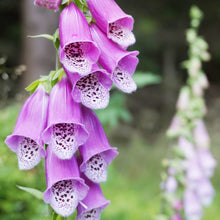*Designated an invasive species in the following states, no sale: AK, CA, OR
Just a look at the drooping bell-like flower of Purple Foxglove is enough to convince one of why Western European mythological tales feature them as dwellings, hats, and gloves for elves or fairies. Digitalis perhaps originates from ‘digitus,’ for ‘finger’ or ‘thimble,’ with purpurea meaning ‘purple.’ This is believed to have been coined by German botanist Leonhardt Fuchs in his 1542 herbal. The common name ‘Foxglove’ likely derives from the Anglo-Saxon ‘foxes-gliew’ with ‘gliew’ meaning ‘bell,’ thus, ‘foxes music.’ This naming has also led to folk tales of naughty fairies who give foxes gloves so that they might sneak around the chicken coop! Other titles indicate such fantastical connotations— Fairy Thimbles, Witches Gloves, Lady’s Gloves, Dead Men’s Bells, Bloody Bells. The spookier vernacular that surrounds this lovely plant is an indication of its extreme toxicity; the leaves of Digitalis purpurea are the source of the compound digitalis, containing the glycoside digitoxin, which is fatal unless properly prepared and dosed by a professional. One should never attempt to eat or work with Foxglove, taking care to not plant this in a space where curious children or animals might stumble upon it. Have caution in handling the plant, as skin contact with the root or aerial parts could cause irritation.
The 1785 physician William Withering discovered its herbal applications, though unfortunately, sometimes to fatal effects. Despite its complicated history, Foxglove’s progression into a less volatile pharmaceutical has saved countless lives since the initial faulty results of it as a British folk remedy.
Another traditional use of this plant is in manufacturing of dyes; the blossoms and other parts of Purple Foxglove yield a pinkish-purple bath that then pigments fabrics to a peapod or apple-green color. It seems that at one time, a black dye was made from the leaves for the purpose of painting lines on the stone of Welsh cottage floors as an anti-witch charm. Remember to wear gloves and take care when harvesting this plant for dyeing endeavors.
Native throughout temperate Europe, this plant naturalizes well in human-disturbed lands throughout the US, and can reseed itself to create a beautiful cluster if allowed to. Hummingbirds and bees go mad for their fascinating tubular blooms, and birds flock to their seed heads come fall. Lush clumps of Foxglove will gladly grow in wild or domesticated conditions. Digitalis purpurea, cultivated for at least six hundred years, has become a classic cottage flower in British gardening. These low maintenance spikes add an elegant spire to one’s land, and make for beautiful cut flowers in the home. Cultivated since 1000AD, the Foxglove did not find its way into American gardens until the 1700s, where it continues to delight with its whimsy.












